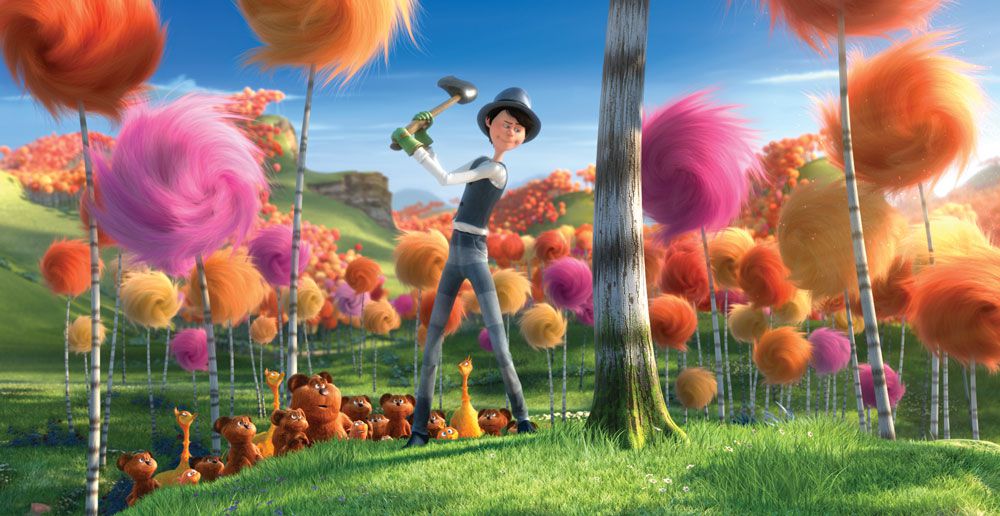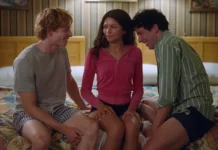From Director Chris Renaud, known for “Despicable Me” and “The Secret Life of Pets,” the 2012 feature film adaptation of Dr. Suess’ beloved children’s story, “The Lorax,” presents a sickening view of a future devoid of nature. The film opens in Thneedville, a fictional town in which grass and trees are made of plastic, and atmospheric pollution is so severe that citizens are compelled to purchase fresh air for their homes. One man in particular, the film’s de facto villain, Aloysius O’Hare, is worth billions of dollars with his air-industry monopoly. He makes a spectacle of his wealth and status by flying in an O’Hare Air blimp, a surely high-pollutant vehicle that adds to the environmental degradation of Thneedville.
Despite all this, however, the people express nothing but jubilation at living in such a manufactured place. In the first high-energy musical number of the movie, smiling citizens affectionately refer to their city as “have-everything-you-need-ville,” a paradise in which things that appear glaringly problematic to any mature viewer, like radioactive water that turns a boy glow-stick green, are not to be fretted over. It is then revealed in act one that most of these people have never seen living trees. With no concept of what the world used to look like, they are content in their man-made bubble.
It’s only when the film’s main protagonist, a tween boy named Ted, first ventures outside of town to investigate what happened to the trees that the true state of nature is revealed. The barren wasteland beyond the steel border wall encircling Thneedville is utterly depressing. It’s depicted in an almost monochromatic indigo, a stark departure from the vibrant and varied tones of the city, which has a definite emotional impact. Thunder claps as Ted rides his motorbike through fields of tree stumps to the sole dwelling outside town boundaries, the Once-ler’s house. The Once-lor, who hides behind a boarded-up window when Ted comes to talk to him, clearly regrets the actions of his younger self, an entrepreneur with a lofty dream whose greed blinded him from the devastating effects his business practices would have on the environment.
As the Once-lor begins telling Ted the story of the trees, the film returns to a view of the world before it was destroyed by industry. When the Once-ler first arrived, the region was a lush wonderland. Many species thrived together in harmony; fish sang and danced in a glistening river and families of bears frolicked among the brightly colored truffula trees. This was an ecosystem undisturbed by the Anthropocene. The sublime portrayal of the world as it was makes the world Ted inhabits seem even more dismal in comparison, an intentional and effective move on the part of the filmmaker.
If only the Once-lor had heeded the warning of the eponymous Lorax! The Lorax, who “speak[s] for the trees,” acts as the voice of the environmentalist movement in the film. The wise, orange, mustachioed creature is summoned down to earth when the young Once-ler chops down his first tree. The Lorax urges him to leave, and then, failing to persuade him to do so, makes the Once-ler promise that he won’t chop down any more truffula trees.
Before he departs, The Lorax utters a prudent assertion to the young businessman; “A tree falls the way it leans, be careful which way you lean.” If the Once-ler had kept his promise, the wooded landscape would have still existed for Ted’s generation to enjoy. But he didn’t. It was only because the Once-ler began to harvest trees to mass-produce thneeds, and didn’t stop harvesting, that the world ended up in the state of ruin that it did. As demonstrated in the song “How Bad Can I Be,” he acted with total disregard for anything but his self-interest and the perpetual accumulation of more and more wealth.
This narrative parallels the real history and trajectory of global climate change. The aggregate pollution from factories and power plants has already had catastrophic effects on the planet. If society doesn’t find a way to put corporations in check to mitigate greenhouse gas emissions, and soon, the real world may come to resemble the lifeless dystopia depicted in “The Lorax.”
Luckily, though, since “The Lorax” is a movie made for children, its final act goes to a more optimistic place. The Once-lor reminds Ted of the power he holds as a determined young person to change Thneedville, and consequently the world, for the better. Empowered by his penitent old mentor, Ted returns to the city to remind people of the suboptimal reality they’re all living in and ultimately act as a catalyst for environmental restoration and the take-down of O’Hare Air.
The film leaves viewers young and old with a feeling of hope, displaying the transformative power of individual and collective action to solve the world’s most pressing problems. Its main takeaway: if we as a society pay attention to what’s most important and care enough to overcome large-scale transgressions, we can create a future to be proud of. It’s never too late.








